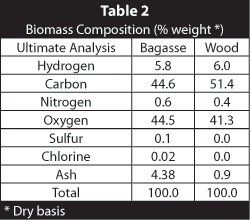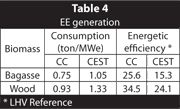Biomass-to-liquids in Brazil
 There's a steady competition of ideas between biofuel producers in the North, and those in the South. First generation biofuels - such as sugarcane ethanol - are far more efficient than comparable fuels made from crops grown in temperate climates, such as corn ethanol, which has a very weak energy balance. For this reason, the South and energy analysts from energy institutes like the IEA are calling for the creation of a regime promoting global biofuel trade, in which the developing world supplies world markets and generates export revenues from it (earlier post). Brazil's efforts on this front, which resulted in a cooperation agreement with the US, clearly make this point.
There's a steady competition of ideas between biofuel producers in the North, and those in the South. First generation biofuels - such as sugarcane ethanol - are far more efficient than comparable fuels made from crops grown in temperate climates, such as corn ethanol, which has a very weak energy balance. For this reason, the South and energy analysts from energy institutes like the IEA are calling for the creation of a regime promoting global biofuel trade, in which the developing world supplies world markets and generates export revenues from it (earlier post). Brazil's efforts on this front, which resulted in a cooperation agreement with the US, clearly make this point.But the North is investing heavily in so-called 'second generation' biofuels, which utilize a far wider variety of biomass feedstocks, such as wood chips and agro-forestry residues. These ligno-cellulosic feedstocks can be converted into liquid fuels via a biochemical conversion process, using special enzymes, or via a thermochemical process based on biomass gasification and Fischer-Tropsch synthesis ('biomass-to-liquids'), which results in 'synthetic' biofuels (earlier post). The North hopes these technologies will ultimately surpass the efficiency of biofuels produced in the South.
Obviously, this will not be the case if countries in the tropics and subtropics utilize the very same processes. The basic fact remains that biomass productivity in the South is naturally higher than that in temperate climates, resulting in competitive advantages that cannot be changed fundamentally. Consequently, the entire discussion about trade barriers and biofuel subsidies will not become obsolete with the arrival of second generation biofuels. (For a good and frequently updated overview of the Brazilian perspective on biofuel trade discussions, check Henrique Oliveira's Ethablog).
After decades of investments in an ultimately highly successful first generation biofuel - sugarcane ethanol - Brazil now is waking up to the potential of these next-generation biofuels. Proof is an interesting overview written for the Energy Tribune by Fernando B. de Oliveira, a process engineer, and Sirlei S. A. de Sousa, is a senior gas-to-liquids consultant at the Petrobras R&D Center in Rio de Janeiro. We replicate their 'opinion piece' here integrally, for future reference. The authors make the case as to why second-generation biofuels produced in the South will be far more competitive than those produced in the US or the EU.
The following is their analysis of the potential to generate liquid hydrocarbons through gasification and Fischer-Tropsch synthesis from two abundantly available biomass streams in Brazil, namely wood and bagasse. The wood stream would come from dedicated energy plantations in which trees like Eucalyptus and Acacia would be grown in short-rotation cycles. A recent analysis by a consortium of European academic institutions put Brazil's explicitly sustainable long-term wood plantation potential at 46 million hectares (earlier post). Bagasse, the other biomass resource, is a byproduct from first generation sugarcane ethanol production:
 biomass :: bioenergy :: biofuels :: energy :: sustainability :: sugarcane :: bagasse :: eucalyptus :: energy crops :: cellulosic ethanol :: gasification :: Fischer-Tropsch :: synthetic biofuels :: Brazil ::
biomass :: bioenergy :: biofuels :: energy :: sustainability :: sugarcane :: bagasse :: eucalyptus :: energy crops :: cellulosic ethanol :: gasification :: Fischer-Tropsch :: synthetic biofuels :: Brazil :: Biomass to Liquid process (Fischer-Tropsch synthesis)
The synthesis of hydrocarbons from carbon monoxide, CO hydrogenation over transition metal catalysts, was discovered in 1902. Collectively, the process of converting CO and H2 mixtures to liquid hydrocarbons over a transition metal catalyst has become known as the Fischer-Tropsch synthesis. Two main characteristics of FTS are the unavoidable production of a wide range of hydrocarbon products and the liberation of a large amount of heat from the highly exothermic synthesis reactions.
Consequently, reactor design and process development has focused heavily on heat removal and temperature control. The focus of catalyst development is on improved catalyst lifetimes, activity, and selectivity. Product distributions are influenced by temperature, feed gas composition (H2/CO), pressure, and catalyst type and composition. There are four main steps to producing FT products: syngas generation, gas purification, FT synthesis, and product upgrading.
When the feedstock is biomass, its conversion to a suitable feed gas for FTS, containing H2 and CO, takes place through gasification. But in this case, a pre-treatment prior to gasification is required, and generally consists of screening, size reduction, magnetic separation, “wet” storage, drying, and “dry” storage. Gasification can take place at different pressures, either directly or indirectly heated (lower temperatures), and with oxygen or air. Direct heating occurs by partial oxidation of the feedstock, while indirect heating occurs through a heat exchange mechanism. Upgrading usually means a combination of hydrotreating, hydrocracking, and hydroisomerization in addition to product separation. Unlike conventional fuels, FT fuels contain no sulfur and low aromatics. These properties, along with a high cetane number, result in superior combustion characteristics.
Discussion
From the information available in the literature, our studies suggest the use of a process, based on the FTS, aiming at the best use of wood and sugarcane byproducts (bagasse/trash) for the production of high-quality liquid byproducts, such as diesel, naphtha, base oils, and paraffin, and also the concomitant generation of electricity.
The scheme of the chosen process involves the following steps: biomass pre-treatment section, generation of syngas through the gasification process (atmospheric fluidized bed air blown gasifier), and adjustment of the ratio of the H2/CO to be fed to the Fischer-Tropsch reactor (cobalt-based catalyst) through a shift reactor. In Tables 1 and 2, the elementary and immediate analyses of biomass can be found in percentage weight adopted in this study.

 Table 3 shows the results of biomass consumption for their two feedstocks, aiming at the production of high-quality liquid byproducts as well as electric power generation.
Table 3 shows the results of biomass consumption for their two feedstocks, aiming at the production of high-quality liquid byproducts as well as electric power generation.The results listed in Table 3 show a decrease of around 13 percent in the consumption of biomass when wood is used to supply the process. The advantages and disadvantages of this scheme need to be studied further, considering, for example, the availability and cost of the raw materials.
 Using entirely the syngas generated in the gasification stage, this study also estimated (Table 4) the potential for electric power generation considering a Combined Cycle – CC – and a Condensing Extraction Steam Turbine – CEST.
Using entirely the syngas generated in the gasification stage, this study also estimated (Table 4) the potential for electric power generation considering a Combined Cycle – CC – and a Condensing Extraction Steam Turbine – CEST.Electricity Generation
It is important to point out that FTS produces a residual gas stream that may be used to generate electric power through a combined cycle. This allows the sugarcane bagasse to be directed towards plant BTL, thus increasing the production of liquid byproducts and keeping the electric power generation for use by the plant and/or neighborhoods. Various studies are currently trying to perfect the generation of electric power and the production of liquid byproducts with or without power generation via FTS.
All start from the most diversified generators of biomass, aiming to increase the use of this kind of raw material for the world’s energy sources, thus decreasing dependence on non-renewables. Currently, most efforts are concentrated on the development of adequate gasification processes for each type of biomass.
In the case of Brazil, some studies have already demonstrated the viability of bagasse and trash from sugarcane processing as a feedstock in ethanol fuel mills.
 --------------
--------------


 Fuel Tech, Inc., today announced a demonstration order for its 'Targeted In-Furnace Injection' program, part of a set of technologies aimed at controlling slagging, fouling, corrosion, opacity and acid plume problems in utility scale boilers. The order was placed by an electric generating facility located in Italy, and will be conducted on two biomass units burning a combination of wood chips and olive husks.
Fuel Tech, Inc., today announced a demonstration order for its 'Targeted In-Furnace Injection' program, part of a set of technologies aimed at controlling slagging, fouling, corrosion, opacity and acid plume problems in utility scale boilers. The order was placed by an electric generating facility located in Italy, and will be conducted on two biomass units burning a combination of wood chips and olive husks.








0 Comments:
Post a Comment
Links to this post:
Create a Link
<< Home